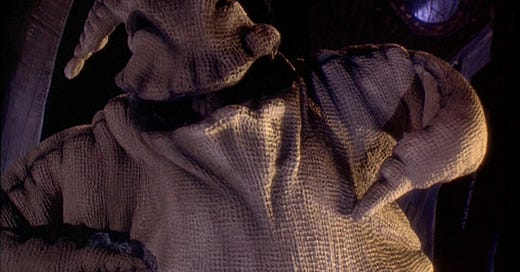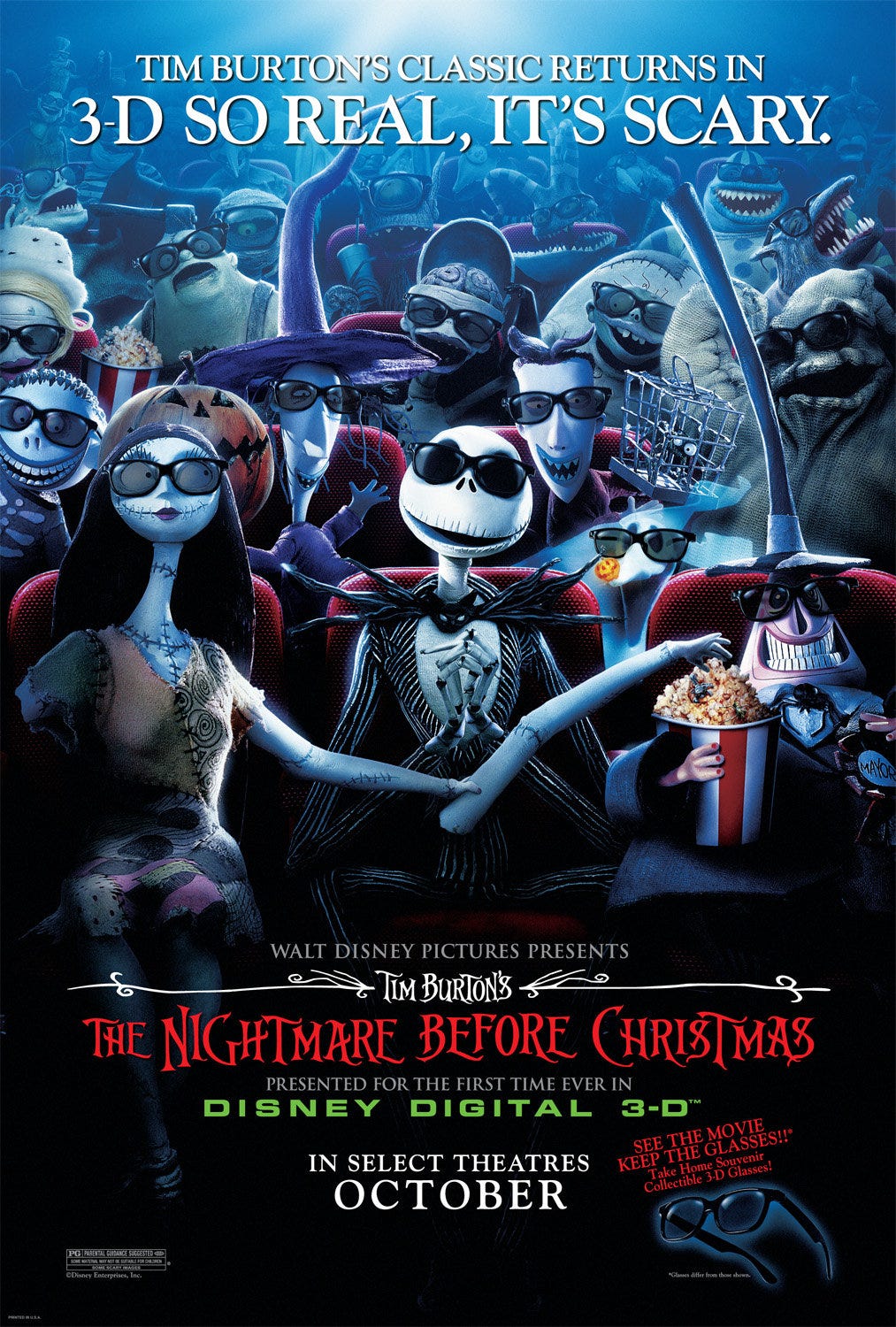The Nightmare Before Christmas (1993) is a Useful Allegory for Cultural Appropriation
Guest post alert! Audi Barnes, my dear friend and copywriter in arms at our place of business, is making her triumphant return to Dust On The VCR after she kicked off my Mummy Month experiment in January of 2022 with her glowing piece about Brendan Fraser’s real-life heroism. If you’re a longtime reader here, you might recall that I wrote a couple years ago about how November 1 (that’s today!) is the perfect day to watch The Nightmare Before Christmas, and it’s been my policy until now to cover any given film only once. (Well, except for The Mummy, I guess.) But this brilliant observation just poured out of Audi’s brain and she sent it to me so I could provide a home for it, and once I read it, I knew I couldn’t say no. So here we are, on November 1, talking about this delightful film a second time—but in a very different way. Take it away, Audi!
I have a confession to make: I’ve been terrified of The Nightmare Before Christmas since I was a young girl who chanced upon that scene with Oogie Boogie. You know, the one where his skin unravels to reveal a writhing mass of fetid insects.
In my opinion, it’s pretty reasonable that a movie meant to look off-putting would leave me with lingering dread. But I’ve been told by many people over the years that the quality of the movie as a whole warrants giving it the ol’ college try.* So I did. And though I still squirmed a fair amount, I was rather taken with it. Not by the beauty of the stop-motion animation or by Jack’s desperation to find purpose beyond his career, though. By how well The Nightmare Before Christmas acts as an allegory for cultural appropriation.
If your hackles are raised, I understand. But I promise I’m not here to make you feel bad about something you hold dear or to ruin a movie you love. In fact, looking through this lens might give you a greater appreciation for it.
It’s my best friend Nicole’s favorite movie, and she’s the one who told me to keep an open mind over a flimsy plate of plasticky nachos at our drive-in screening. She also said she’d chanced upon the idea that the film serves as an excellent allegory, but she wouldn’t tell me for what. She wanted me to come to the conclusion on my own.
Jack’s deep appreciation for the spectacle of Christmas is genuine: He’s yearning for something new, and Christmas is the antithesis of what he’s used to. It’s bright and colorful and warm, and for someone who feels trapped in the doldrums of his job as a deliverer of fear, the allure of Christmas is undeniable. None of us could resist that pull—nor do we need to. Appreciating new cultures is a beautiful thing; it’s how we form relationships with people we don’t know, broaden our understanding of the world around us, and lead richer, fuller lives.
The semi-recent popularity of K-pop in the West, for example, has influenced mainstream music culture, brought new foods into our supermarkets, and given us more immediate access to knowledge about a culture we might not have been exposed to otherwise. Since BTS blew up worldwide, I’ve learned about the military draft in South Korea and developed a frankly unhealthy relationship with Korean candy and instant coffee.
When Jack participates in the Christmas tradition and shares it with his loved ones, it’s a perfectly innocent and joyful act, especially because we as the viewer know that Christmas isn’t a closed practice—it’s meant to be shared. Jack appreciates the holiday even though he doesn’t have the language to communicate what makes Christmas Christmas, and it’s clear that he wants to deepen his understanding and share his love for the holiday. He may not have the tools that a more lived experience of Christmas would give him, but he recognizes his lack of knowledge and does his best to educate himself.
Things get sticky when Jack decides a night of research is enough to make him an expert—nay, a leader. When he says “I bet I could improve [Christmas] too, and that’s exactly what I’ll do,” that moment—played up with deliberate menace—is when my lightbulb went off. It serves as the inciting incident for the conflict that follows, and it helped me understand what Nicole first heard about The Nightmare Before Christmas a few years ago.**
Jack’s initially innocent excitement for the holiday evolves into a much greedier desire to put himself at the center of the tradition. What comes from it is a chaos that Christmas Town suffers for until Jack recognizes that he’s not being true to himself. The Pumpkin King can surely celebrate Christmas, but he can’t be Santa Claus—only Santa Claus can. Taking what doesn’t belong to him to fulfill his own desires deeply hurts the community he stole from. It ultimately leaves him empty until he steps out of the spotlight and puts the actual leader back in power to undo the damage he caused.
Now, did producer Tim Burton and director Henry Selick aim to make The Nightmare Before Christmas an allegory for cultural appropriation? I highly doubt it. But I think it serves as a great tool to discuss where the line between appropriation and appreciation falls for people who are new to those terms.
Some may find that more frightening than watching a woman sew herself back together.*** But in my mind, nothing could ever top the malodorous horrors lurking under Oogie Boogie’s stained sack. Burton and Selick need therapy.
*Jeremy very much included.
**This was in the era of anti-racism education kicked off by the George Floyd protests. Nightmare was being pitched as a tool to teach about children appropriation.
***I could write a whole ‘nother essay on Finkelstein’s possession of Sally. I initially thought the allegory Nicole was referencing was medical paternalism and abuse of power.
The Nightmare Before Christmas is now streaming on Disney+ and Crunchyroll, and it is available to rent elsewhere.






